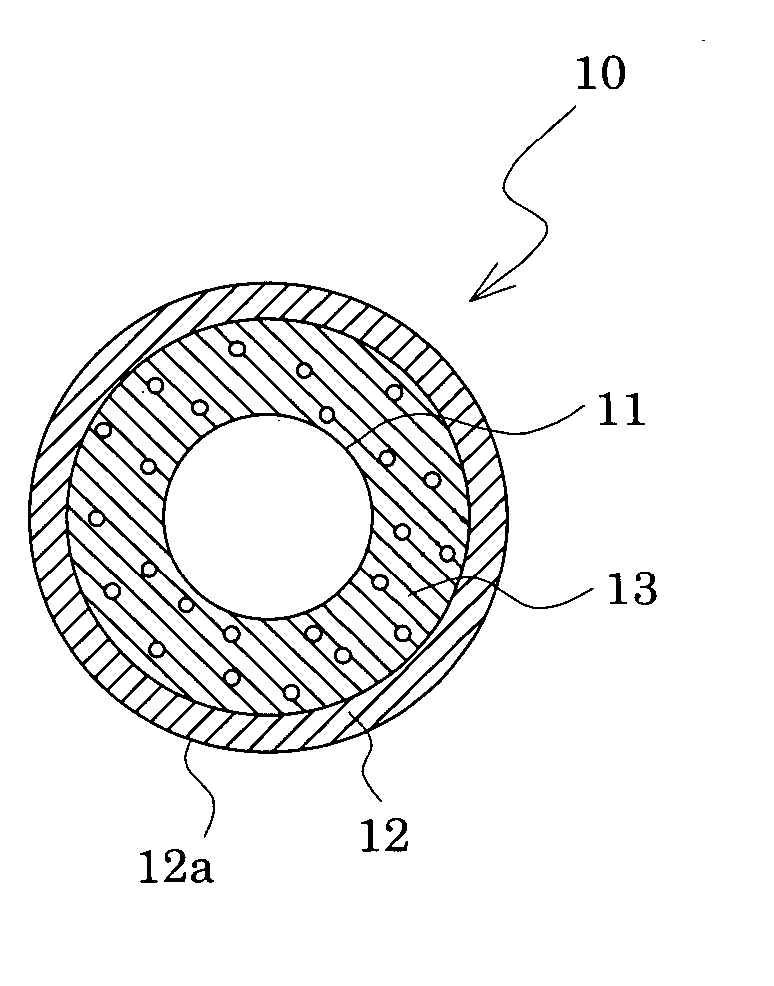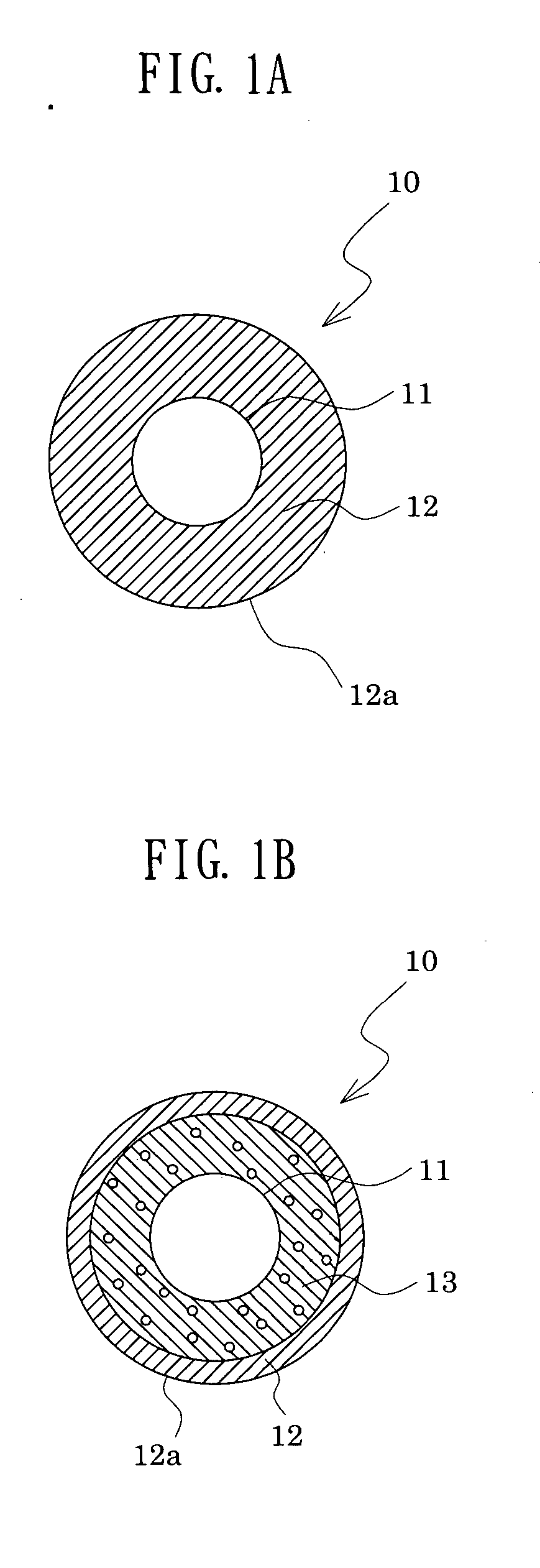Conductive rubber member
a technology of conductive rubber and conductive rubber, which is applied in the direction of liquid handling, instruments, and closures using stoppers, can solve the problems of poor processability of epichlorohydrin rubber, improved productivity or cost reduction, and defective epichlorohydrin rubber, etc., and achieves excellent processability, low cost, and satisfactory characteristics.
- Summary
- Abstract
- Description
- Claims
- Application Information
AI Technical Summary
Benefits of technology
Problems solved by technology
Method used
Image
Examples
example 1
Production of Roll:
[0046] To 100 parts by mass of moderately high nitrile content type acrylonitrile-butadiene rubber, 10 parts by mass of TOKABLACK #5500 (TOKAI CARBON), 25 parts by mass of ASAHI THERMAL, 1.5 parts by mass of Sanceler TET (SANSHIN CHEMICAL INDUSTRY), 1.5 parts by mass of Sanceler CZ (SANSHIN CHEMICAL INDUSTRY), and 1.0 part by mass of sulfur were added, and the mixture was kneaded by a roll mixer. The kneaded materials were extruded onto a φ6 mm shaft, and then the extrudate was cured (160° C.×30 min) to form a rubber roll having an inner diameter of φ6 mm and an outer diameter of φ10 mm.
Preparation of Surface Treating Solution:
[0047] To 100 parts by mass of ethyl acetate, 10 parts by mass of an isocyanate compound (MDI) was added, followed by mixing and dissolving, to prepare a surface treating solution.
Surface Treatment of Roll:
[0048] With the surface treating solution being held at 23° C., the above roll was dipped therein for 60 seconds, whereafter the ...
example 2
[0049] Ethyl acetate (100 parts by mass), 4 parts by mass of acetylene black (DENKI KAGAKU KOGYO), and 2 parts by mass of an acrylic silicone polymer (MODIPER FS700, NOF CORPORATION) were dispersed and mixed for 3 hours in a ball mill. Then, 20 parts by mass of an isocyanate compound (MDI) was added, followed by mixing and dissolving, to prepare a surface treating solution. On the surface of the elastic layer of the same rubber roll as that in Example 1, a surface treatment layer was formed using the surface treating solution, whereby a conductive roll of Example 2 was provided.
example 3
Production of Roll:
[0050] To 100 parts by mass of moderately high nitrile content type acrylonitrile-butadiene rubber, 5 parts by mass of acetylene black (DENKI KAGAKU KOGYO), 1 part by mass of tetraethylammonium perchlorate (KANTO CHEMICAL), 5 parts by mass of factice (Brown PR, TENMAFACTICE MFG.), 15 parts by mass of di(2-ethylhexyl) phthalate (DOP), 1.5 parts by mass of Sanceler TET (SANSHIN CHEMICAL INDUSTRY), 1.5 parts by mass of Sanceler CZ (SANSHIN CHEMICAL INDUSTRY), and 1.0 part by mass of sulfur were added, and the mixture was kneaded by a roll mixer. The kneaded materials were injection molded by a pipe mold having a φ6 mm shaft set therein, and then the molded product was cured (160° C.×30 min) to form a rubber roll having an inner diameter of φ6 mm and an outer diameter of φ10 mm.
Preparation of Surface Treating Solution:
[0051] Ethyl acetate (100 parts by mass), 2 parts by mass of acetylene black (DENKI KAGAKU KOGYO), and 1 part by mass of an acrylic fluoropolymer (...
PUM
| Property | Measurement | Unit |
|---|---|---|
| melting point | aaaaa | aaaaa |
| melting point | aaaaa | aaaaa |
| RH | aaaaa | aaaaa |
Abstract
Description
Claims
Application Information
 Login to View More
Login to View More - R&D
- Intellectual Property
- Life Sciences
- Materials
- Tech Scout
- Unparalleled Data Quality
- Higher Quality Content
- 60% Fewer Hallucinations
Browse by: Latest US Patents, China's latest patents, Technical Efficacy Thesaurus, Application Domain, Technology Topic, Popular Technical Reports.
© 2025 PatSnap. All rights reserved.Legal|Privacy policy|Modern Slavery Act Transparency Statement|Sitemap|About US| Contact US: help@patsnap.com


